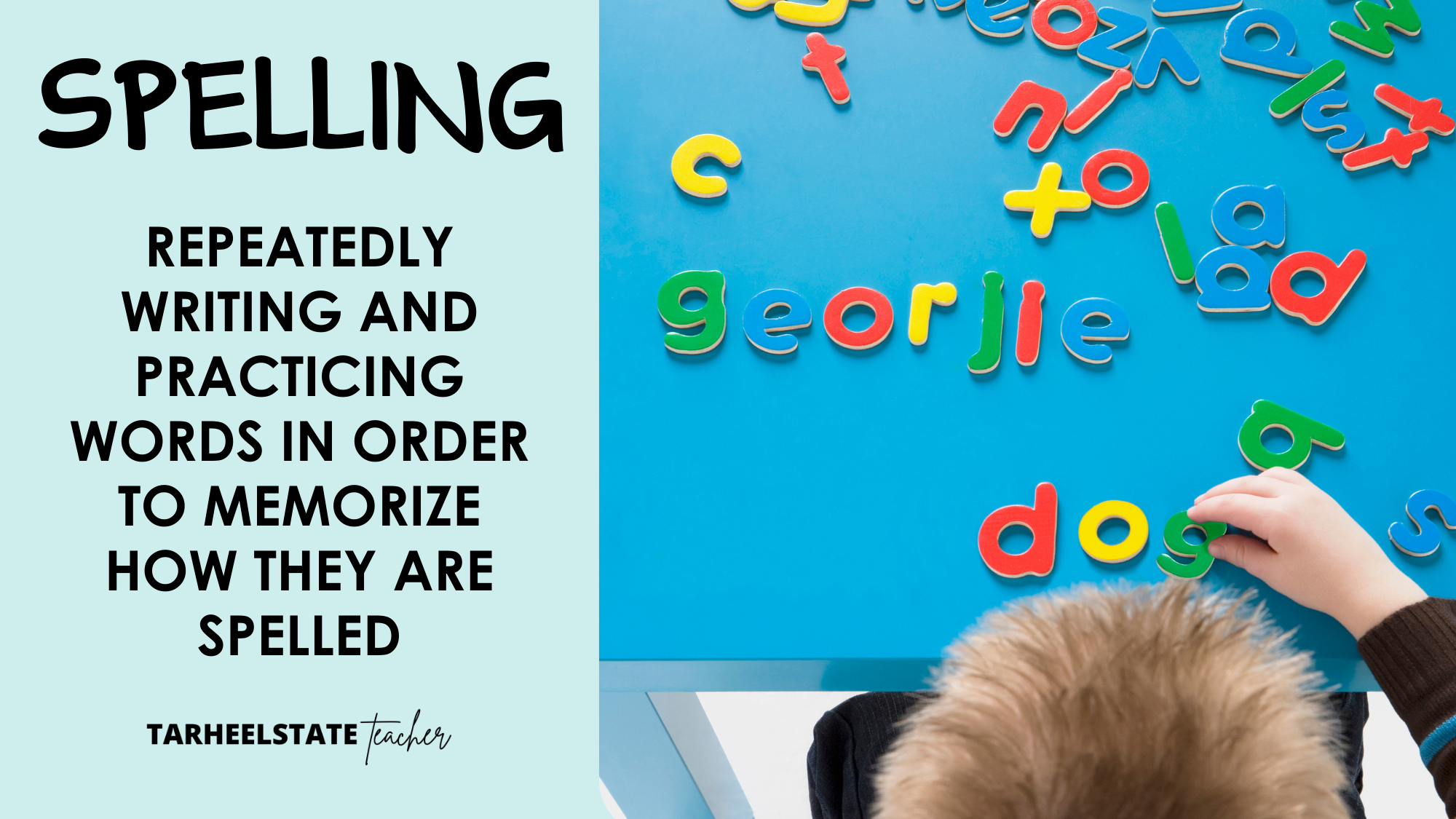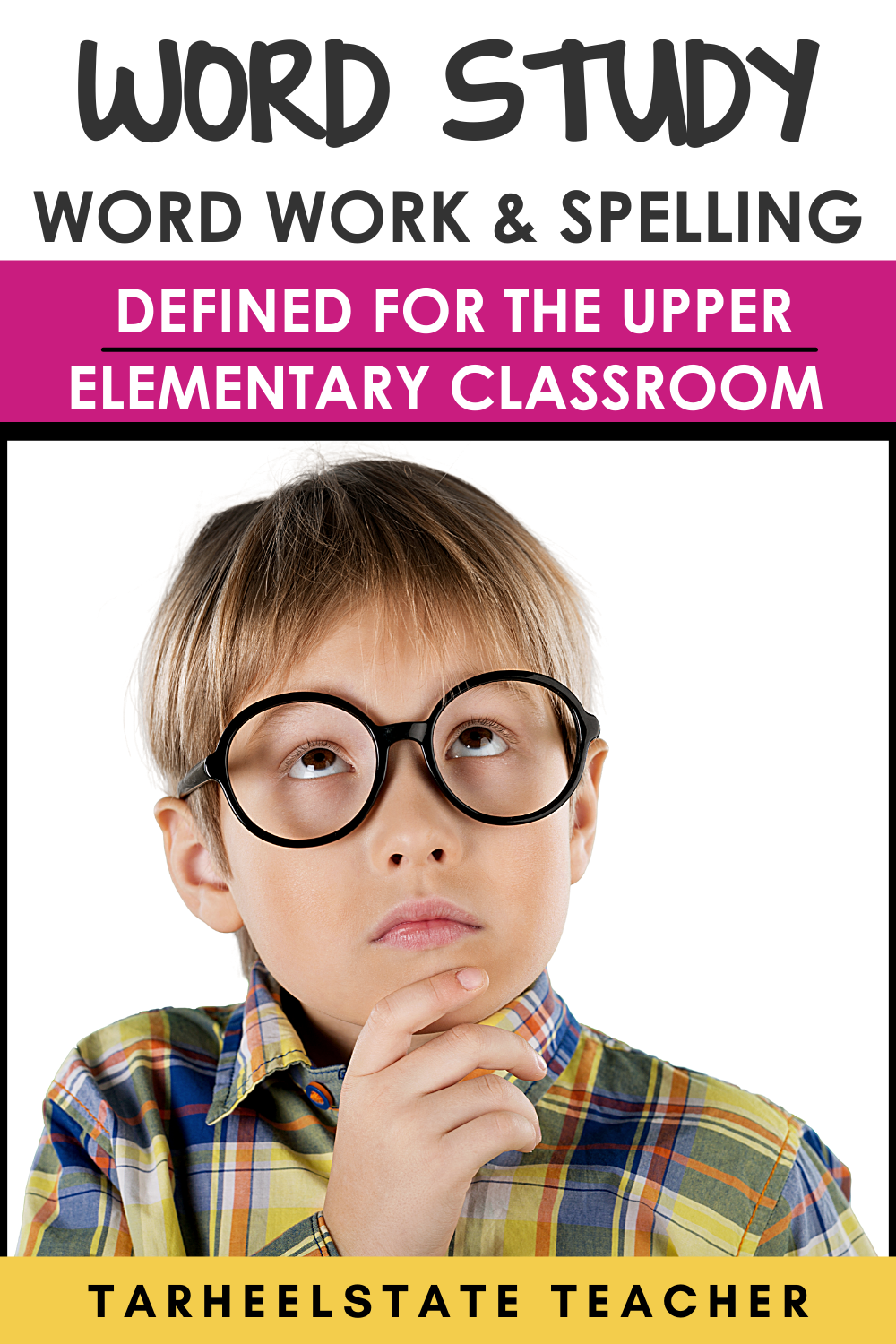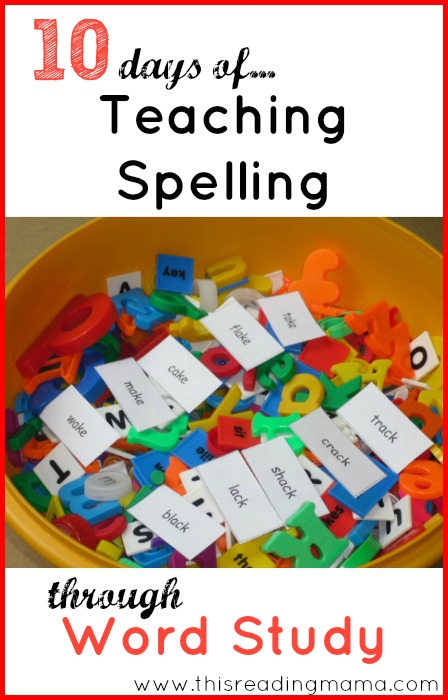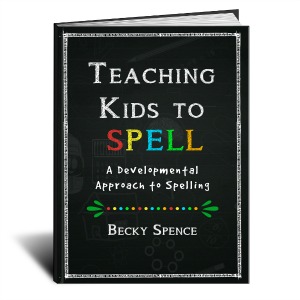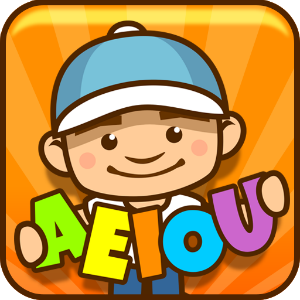Word study, word work, and spelling…confused about the difference and why it matters in your upper elementary classroom?! These three types of word learning structures often get thrown around interchangeably in the upper elementary teaching world, but they have important differences in approach and purpose. You may have landed on this blog post as a new teacher who really wants to know what distinguishes each practice, as a veteran teacher who’s curious to see if our definitions match, or as someone who falls in between. While word study, word work, and spelling have quite a bit of crossover, there are also some fundamental differences that we should take into consideration.
I was always an A+ speller, but I had everything going for me in that department—I loved to read, my ability to memorize was fantastic, my enjoyment of all things school and my type-A personality allowed me to thrive on practice worksheets, I loved having my mom call words out to me to spell, and I gave myself my own spelling tests to make sure I would do well on the tests…heck, I probably even had index cards to help myself focus on any words with tricky spellings. How many of your students sound like that kind of kid?!
In recent years there has been a shift away from traditional spelling programs where students focus solely on memorizing a list of (possibly) random words in order to perform well on a spelling test. Teachers and parents alike often complain that students are able to perform well on spelling tests but continue to misspell words in their written work. It’s like cramming for a test and then forgetting much of the information once time has passed.
Before we get into my recommendations for an upper elementary word study/spelling program that works, let’s make sure we have a good understanding of the nuances of spelling, word study, and word work.
WHAT IS SPELLING?
Traditional spelling instruction focuses on learning to spell words correctly given a list of words. In upper elementary, how words end up on a students’ spelling list can run the gamut. The word list can be based on a spelling pattern, personalized based on a sight-word assessment, derived from books students are reading, come from content area vocabulary, or a combination of sources. Language Arts textbooks and literacy curriculums often include lists of spelling words and lessons for students to complete but they are often not based on developmental spelling levels or individual students’ needs.
In hopes of differentiating spelling lists, teachers sometimes have students choose half of their words from a class word list and half of their words from a “personal” list of words that students need to master.
While a spelling program can teach phonics and word pattern concepts, the focus is often on memorization, spelling tests, and moving on to new words the following week. Spelling activities often involve repeated activities and practice writing words so that students can spell them correctly when they are tested on them—think “three times each,” rainbow words, word pyramids, ABC order, and more as ways to make it fun for students to write their spelling words again and again.
WHAT IS WORD STUDY?
In word study programs, students are guided to discover and make generalizations about patterns in words and how words work. Word study aims to improve students’ ability to read words, spell words accurately, and understand the meaning of words, including how adding different word parts modify word meanings. “Studying” words is a foundational aspect of word study and moves away from a strict focus on memorizing how words are spelled.
For example, students participating in a word study block may be learning about words that end in -ck and -ke. Through reading, sorting, searching for, and writing words that fit in this particular category, students are guided to discover that most words ending in -ke make the long vowel sound, while most words ending in -ck make a short vowel sound. In word study, students move from noticing similarities and differences in word patterns, sounds, and spellings to being able to verbalize a common rule or way words with those patterns and sounds function.
While spelling words accurately is a goal of word study, so is applying the knowledge of word patterns to spell other words that also follow the spelling pattern; transferring their learning to spell new words is a key goal of word study.
Differentiation is another cornerstone of a true word study program. In classrooms where word study is implemented, students are assessed with a spelling inventory to see where they are in their understanding of phonics and word patterns. The inventory contains a variety of words and increases in complexity to identify students’ mastery of sound patterns and ability to represent the sounds they hear through spelling.
Based on the assessment, students are grouped by their developmental level. For example, students who don’t show a solid understanding of long vowel patterns would not be studying how prefixes and suffixes impact a word’s meaning in the scope of word study (although, the teacher may implement whole group lessons focused on Greek and Latin roots and students will surely encounter those kinds of words in content areas like science and social studies.)
Word study often involves tactile sorting of words on word cards where students group words based on spelling patterns and sounds. Students then document their word sorts by copying it down on paper. This practice helps students think about and come up with ideas about how the words work.
WHAT IS WORD WORK?
Word work is largely used with pre-readers and early readers in preschool and lower elementary grades with a focus on phonics, sight words, and spelling—all critical for our earliest readers! It consists of a variety of teacher modeling, hands-on activities, and games that encourage word building and word reading. In my experience, word work has usually been a component added into students’ guided reading time. Many lower grades teachers try to add a few minutes of word work at the start or end of most of their guided reading lessons.
Word work should bring to mind images of students building words and writing different words repeatedly. During word work, students may learn about word families like -at and -an. They can practice reading and writing new words by changing the beginning consonant (pat/mat/cat and fan/man/pan). Word work is also a time to help students memorize high frequency words that are key for developing as readers. Playing with words and manipulating parts of words is a key component of word work.
WHAT’S AN UPPER ELEMENTARY TEACHER TO DO?
I have found that a well balanced word-learning program has the best aspects of word study, word work, and spelling AND as the teacher, you should be well aware of your goals for whichever program you choose to implement.
I can’t not say this—word study/spelling time needs to be differentiated based on students’ developmental levels. If not, in my experience spelling time just feels like a punishment to some students and a waste of time for others. The days of having all students in a class or grade level working to master and spell the same word list should be a thing of the past for upper elementary classrooms. And, when your students’ assignments are based on their developmental level, they’ll be more eager to participate and have a growth mindset about their spelling and word attack abilities.
Next, we can use elements of word work to bring fun and engagement to our word study program. Games and activities can give students many opportunities to see and work with words and word patterns. These word-work-like experiences will naturally support our upper elementary students in making generalizations about spelling patterns, word pronunciations, and word meanings.
My ultimate recommendation for upper elementary teachers is to create an inquiry-based word study routine where the foundational goal is for students to learn to generalize the consistencies they notice in words in ways that help them become better readers and writers. This routine should incorporate 1-2 days of playing with words and sounds and 1-2 low-stress days that are focused on spelling words accurately. #teachersonamission!
Because I’ve realized that the hands-on FUN was missing from my word study routine, I’ve spent 2021 running down the long path of creating word study games and activities for all levels of word study. These games and centers are aligned to Words Their Way, but can complement any word study program where the focus is on word patterns and sounds. See what these are all about here! With the addition of board games, card games, spinners, and picture board activities, you are sure to find the spark of joy in word study that I’ve felt all these years!
Struggling to picture what this would look like on paper?! Don’t worry! I’ve got you covered in some upcoming posts about word study routines and schedules! Stay tuned! (Or, better yet, grab your FREE Word Study Terminology download and you’ll be updated when I publish new posts about word study!)
HELPFUL RESOURCES FOR UPPER ELEMENTARY WORD STUDY
*This post contains affiliate links. To read more, please see my full disclosure policy.
For the next two weeks, I’m honored to be joining 39 other bloggers in iHomeschool Network’s Hopscotch! I’ll spend 10 days showing how effective Word Study is in teach spelling. I have used word study in the classroom, as a private reading tutor, and now as a homeschooling mom! It is ideal for one child or multiple children! You can read more about word study yourself in Words Their Way: Word Study for Phonics, Vocabulary, and Spelling Instruction.
Teaching Spelling Through Word Study Topics for Each Day:
- Day 1: What Exactly is Word Study?
- Day 2: The Stages of Spelling Development
- Day 3: Invented Spelling: What the Errors Tell Us
- Day 4: Where Do I Start?
- Day 5: Word Sorts: The Heart of Word Study
- Day 6: How to Introduce a Word Sort
- Day 7: Daily Routines with Word Sorts
- Day 8: FUN with Word Patterns
- Day 9: What About Those Irregular Words? (FREEIBE Included)
- Day 10: Word Study: It’s WAY More Than Phonics!
More Resources for Teaching Spelling:
My goal in writing this ebook was two-fold: (1) to help parents understand how spellers develop in learning to spell so that spelling instruction can be developmentally appropriate and (2) to provide strategies for teaching spelling in explicit and hands-on ways. (You won’t find worksheets or boring drills included!)
- Short Vowels Word Study App {purchase for $2.99}
- Using Words Their Way to Teach Spelling
- Free Printable Resource for the most common single syllable vowel patterns
- Learning to Spell with Word Families
- A Better Way to Teach Spelling
- Sight Word Pinterest Board
- Word Study/Phonics Pinterest Board
Enjoy!
~Becky
Presentation on theme: «Word Study Instruction Using Words Their Way»— Presentation transcript:
1
Word Study Instruction Using Words Their Way
2
How do you teach spelling words?
Many teachers teach spelling by giving students a list on Monday and a test on Friday with practice in between. This type of drill and practice has earned traditional spelling instruction a reputation for being boring. That there is no big picture and no ultimate goal makes it all the more tedious – as soon as one spelling list is tested, another list takes its place. Luckily, there is an alternative to traditional spelling instruction called «Word Study» which is not based on the random memorization of words. A word study program is a cohesive approach that addresses word recognition, vocabulary, and phonics as well as spelling.
3
Getting to Know Words Their Way
What is word study? Purpose of Word Study Basics of Word Study Stages of Spelling Development How to Assess and Group Students Typical 5-Day Lesson Plan
4
What is Word Study?
5
Purpose of Word Study The authors of Words Their Way: Word Study for Phonics, Vocabulary, and Spelling Instruction determined that the purpose of word study is twofold. First, students develop a general knowledge of English spelling. They learn how to examine words through active exploration using a hands-on, manipulative approach. Students also discover generalizations about spelling, instead of just spelling rules. They learn the regularities, patterns, and conventions of English orthography needed to read and spell. Second, word study increases students’ specific knowledge of words. Specific knowledge relates to the spelling and meaning of individual words.
6
Basics of Word Study Word study evolved from over three decades of research that explored the developmental aspects of spelling. These researchers examined the three layers of English orthography—alphabet, pattern, and meaning. In their research, they found that each layer builds on a previous layer. Alphabet: The alphabet layer is based on the relationship between letters and sounds. For example, in the word cat, a single letter represents each sound. Students blend the sounds for /c/, /a/, and /t/ to read the word cat. In the word chip, students still hear three sounds even though there are four letters, because the first two function as one sound. These examples show how to create words by combining letters, either singly or in pairs, to form sounds from left to right.
7
Basics of Word Study Pattern:
The pattern layer overlies the alphabet layer because there’s not always a single sound for each letter. In the English language, single sounds are sometimes spelled with more than one letter or are affected by other letters. When students look beyond single letter and sound match-ups, they must search for patterns. For example, a final e will often make the preceding vowel stand for the long vowel sound, like in the word cape (cap vs. cape, gap vs. gape). It follows a pattern of consonant-vowel-consonant-silent e (CVCe Pattern). Meaning: The meaning layer focuses on groups of letters that represent meaning directly. Examples of these groups or letters include prefixes and suffixes. Here is a specific example of how meaning works in the spelling system. Take the prefix re–. Whether students pronounce it as ree like in rethink or ruh as in remove, its spelling stays the same because it directly represents meaning.
8
Stages of Spelling Development
When implementing word study in the classroom, it is important to understand the progression of the stages of spelling development. It will help teachers determine which word study activities are most appropriate for students. The methodology of Words Their Way: Word Study for Phonics, Vocabulary, and Spelling Instruction is based on the progression of these developmental stages. The stages of spelling development are Emergent Letter Name-Alphabetic Spelling Within Word Pattern Syllables and Affixes Derivational Relations These stages describe students’ spelling behavior as they move from one level of word knowledge to the next.
9
Synchrony of Literacy Development
Alphabet Pattern Meaning Emergent Pre-K to middle of 1st Emergent Beginning K to middle of 2nd Letter Name — Alphabetic Transitional Grade 1 to middle of 4th Within Word Pattern Intermediate Grades 3 to 8 Syllables & Affixes Reading Stages Advanced Grade Range Grades 5 to 12 Spelling Stages Derivational Relations
10
Emergent Stage Emergent Stage (Pre-K to middle of 1st):
In the Emergent Spelling stage students are not yet reading conventionally. Spellers in the emergent stage may write with scribbles, letter like forms, or random letters and numbers. In most cases, they have not been exposed to formal reading instruction. During this stage, children learn to recognize and write the letters of the alphabet. They play with the sounds in letters and words. By the end of the level, students understand the concept of words and begin to match picture cards to the words that represent their names. Alphabet Sort for Different Forms of A and B Picture Sort for Initial F and T
11
Letter Name-Alphabetic Stage
LNA Stage (K to middle of 2nd): Students in the Letter-Name Alphabetic Spelling stage have been instructed formally in reading. Spellers in this stage use letter/sound matches to spell the most obvious sounds in words. Often, beginning and ending consonant sounds are in place before vowels begin to appear. At the beginning of this stage, students apply the alphabet principles to consonants. By the end of the stage, they are able to correctly represent most short-vowel patterns, consonant digraphs, and consonant blends. Picture Sort for ch, sh, and th Digraphs Word Sort for the it, ip and ill Families
12
Within Word Pattern Stage
WWP Stage (Grade 1 to middle of 4th): At the beginning of the Within Word Pattern Spelling stage students spell most single-syllable, short vowel words correctly. Throughout this stage, they move away from the sound-by-sound approach of the letter name and begin to include patterns or chunks of letter sequences that relate to both sound and meaning. Spellers in the within-word pattern stage know a great deal about short vowels and the short vowel pattern, the consonant-vowel-consonant (CVC) pattern. In this stage, students begin by exploring the common long vowel patterns. Word Sort for Long-a Patterns, Compared to the Short Vowel Pattern Diphthongs and Other Vowels
13
Syllables and Affixes Stage
SA Stage (Grade 3 to 8th): By the Syllables and Affixes Spelling stage students can spell most one-syllable, short and long vowel words correctly. So, the focus for instruction in this stage is multisyllabic words and patterns. Students also learn to sort by specific vowel combinations, inflected endings, and vowel patterns in accented syllables. In the Middle-Late and Affixes Spelling stage students begin with the study of how syllables divide in words with open syllables, such as cli/mate and re/act, and closed syllables like sup/ply and hun/dred. The level also includes a thorough study of patterns of unaccented syllables. It ends with the study of less common prefixes and suffixes such as fore– and –ness and two-syllable homophones like cellar and seller. Word Sort for Doubling Before -ed Word Sort for Prefixes
14
Derivational Relations Stage
DA Stage (Grade 5 to 12th): At the beginning of the Derivational Relations Spelling stage students spell most words correctly. The focus in this stage is on the meaning connection. In this stage, they learn how to sort words by pattern and meaning with an emphasis on meaning and related word parts. They will discover how spelling preserves meaning even when there are changes in sound. Students will also learn common prefixes and suffixes, examine the meaning of bases and roots, and learn about the classical origin of polysyllabic words. Prefix Sort for astro-, photo-, bio-, chlor-, eco-, hydro-, and hypo- Millennium Word Study and Sort Supplementary Sort: -um, -ium
15
What spelling stage are your students in?
The first step in implementing Words Their Way is a Developmental Spelling Analysis. This is an assessment of students’ knowledge of word features. Based on these results, students are grouped according to ability. Instruction begins at the students’ ability level, which falls into one of the five spelling stages. Once students have been placed in their appropriate stage, instruction begins for the students at what is termed “using but confusing” which are the spelling features they are beginning to use but confuse.
16
Developmental Spelling Analysis
The Primary Spelling Inventory, or PSI, can be used in kindergarten through third grade. The Upper-Level Spelling Inventory, or USI, can be used in upper elementary, middle school, high school, and postsecondary classrooms. If a school system wants to use the same inventory across all elementary grades, they can use the Elementary Spelling Inventory, or ESI. This surveys a range of spelling features throughout the elementary grades, specifically first through sixth grade.
17
Administering the Spelling Inventories
These inventories are administered like traditional spelling tests, but there are some significant differences. Unlike traditional spelling tests, students should not study the words before the assessment. They should also be reassured that they are not graded on the activity. To begin a spelling inventory, students are asked to number their paper. If students are in kindergarten or early first grade, teachers can prepare a numbered paper for students. Each word is called aloud and repeated once. The words are spoken naturally, without emphasis on phonemes or syllables. If necessary, teachers can also use a sentence with the word in it to make sure the students know the exact word. If students struggle with the inventory, teachers can administer a lower-level inventory. The inventory can be given to students as a whole group or in small groups. The results of the inventory can be used to get a general picture of each student’s spelling development.
18
Scoring and Analyzing Results and Forming Groups
Scoring and Analyzing Results Once the appropriate inventory has been administered, you need to set aside time to complete the feature guide for each student. These guides are found in Appendix A of Words Their Way: Word Study for Phonics, Vocabulary, and Spelling Instruction. The feature guide helps analyze and classify student errors, confirm the developmental stages, and pinpoint specific areas for instruction. Forming Groups Students can be grouped for instruction according to the spelling developmental stages or by specific grade level. Student groups can be further differentiated by the three additional stages within each developmental stage or grade level. These stages are early, middle, and late.
19
Word Study in Action Word sorts are the heart of the program. Students use word sorts to group words into specific categories. As students complete the sorts, they compare and contrast word features, make discoveries, and form generalizations about the conventions of English orthography or spelling. Video of Word Sort: PowerPoint Presentations of Word Sorts:
20
5 Types of Sorts
21
Typical Week of Word Study
Monday Students receive words to cut out and write their initials. Students will complete a written “open sort” Teacher introduces words, demonstrates sort in a small group. Students explain why words are being sorted that way. Students take their own words back to their seats and independently replicate the sort. They will then write the sort in their word study notebooks. Tuesday Students re-sort words. They will pick 6 words to draw and label. Wednesday Students will sort words with a partner. They will check each other’s work and discuss any difficulties. Thursday Students sort words. They might have a speed sort against the teacher or with a classmate. Students perform a word hunt using literature currently being read. Friday Review game or activity using words of the week. Spelling Test and Word Sort Assessment.
22
Typical Sort Introduction
23
24
Words Their Way Homework Explanation
Monday: Sort the word cards into categories (this type of sort has been taught at school). For example you might sort out all of the words that have “short a” in them or “long a.” Ask your child to explain to you why the words are sorted in a particular way. Sort the cards a second time as fast as possible (you may want to time them). Tuesday Do a blind sort with your child. Lay down the category cards in a row. For example you would lay down the cards that indicate “long a” or “short a.” Then read a word card aloud, without showing it to your child. Without seeing the word, your child should point to the category that it goes in. Lay down the card. Your child should move it to the correct category if it is wrong. Wednesday Do a word hunt. Look for their words or words with the same sound pattern in books, magazines, or newspapers.. Thursday Have a practice test!
25
Spelling City Spelling city is a free online environment where students can practice and study spelling words. Instead of handing out a paper spelling list at the beginning of each week, give your students a link to Spelling City where they can find the weeks spelling words. Sign up as a Spelling City teacher (free) and enter spelling lists. Students can get onto Spelling City and find spelling lists by searching the teacher name. Spelling city will teach your students the spelling words by saying the word and then using it in a sentence. Students can practice their spelling words by playing games with the words, there are several games to choose from. Spelling city will even give practice spelling tests to students. For a small fee, teachers can set up record books and give the final spelling test online. Put an end to copies of spelling lists and send your kids online. You will save trees and students will get great practice with their words. Spelling City
26
Cool Sites Words Their Way Resources: Vocabulary Ideas and Videos:
PowerPoint Presentations for Word Sorts Companion Website for Words Their Way Words Their Way Online Tutorials Word Sorts Vocabulary Ideas and Videos: Spelling City:


